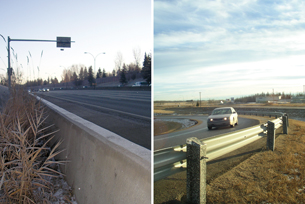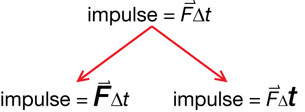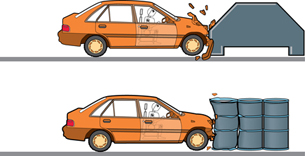Module 1
1. Module 1
1.9. Page 4
Module 1—Momentum and Impulse
Applying Impulse to the Design of Safety Devices

Roadside barriers are designed to reduce injury during collisions.
The technologies of safety features, such as roadside barriers, have been incorporated into the construction of highways and other major roadways. The intent of roadside barriers is to prevent vehicles from swerving off the highway. However, if this is their only purpose, the most appropriate design would be the sturdiest—the concrete barrier. Why, then, are other designs used? What are the links between the laws of motion and the technology of roadside barriers?
 Read
Read
The answers to these questions can be found on pages 463 to 465 of your textbook. As you read these pages, note how the combination of the net force and the time interval are considered in the design devices that protect people from injury.
 Self-Check
Self-Check
SC 7.
- Identify some of the safety devices incorporated into the design of automobiles that protect occupants during a crash.
- Concisely explain the key physics principle behind the use of these devices.
 Self-Check Answer
Self-Check Answer
SC 7.
- Some of the safety devices that are incorporated into the design of automobiles include a padded dashboard, crumple zones built into the body of the vehicle, collapsible steering column, and airbags.
- Each safety device is designed to change the momentum of an object by applying an equivalent amount of impulse. This is described by the following rearranged version of Newton's second law:
 .
.
The safety devices mentioned do this by increasing the time interval required to change the momentum so that the average net force required to stop the motion is minimized.
Two Ways to Apply an Impulse to an Object
Many of the safety devices that are incorporated into the design of vehicles use the idea that the necessary impulse to change the momentum of an object can be applied with smaller net force acting over a larger time interval or a larger net force acting over a smaller time interval.
 |
|
impulse |
impulse |
larger force and smaller time |
smaller force and larger time |
This idea can now be applied to the design of roadside barriers.
 Module 1: Lesson 2 Assignment
Module 1: Lesson 2 Assignment
Remember to submit the answers to A 4 to your teacher as part of Module 1: Lesson 2 Assignment.

A 4. The illustrations show two ways of providing impulse to change the momentum of a vehicle. In the top illustration, the vehicle collides with a massive concrete barrier. In the bottom illustration, the vehicle collides with water-filled barrels.
Explain which type of crash barrier would likely produce less damage to the vehicle and less injury to the occupants.